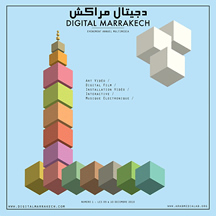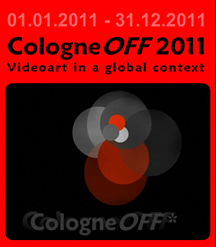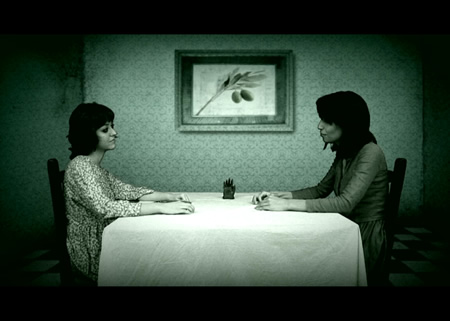|
"Close To My Heart" now available for online viewing(Please disable the pop-up blocker of your browser) |
experimental short videos
|
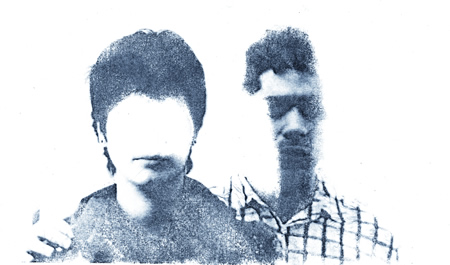 above: video still from"Poéticide (shaér koshi)" by Payam Mofidi |
by Alysse Stepanian In selecting work by Iranian artists for this compilation, I have looked for experimental videos that were informed by the relationship of the artists with their place of birth. I grew up in Tehran and moved to the US at the age of eighteen after the Revolution of 1979, so curating this collection is close to my heart. On a personal level, this has been a valuable opportunity for me to reconnect with my roots and to interact with contemporary Iranian artists. The videos vary from the political, as in Morehshin Allahyari's "Over There Is Over Here," to Hamed Sahihi's sensually metaphorical, "Sundown." Looking through these selections, one senses the magical quality of Persian poetry that pervades this culture. They share a slow sense of rhythm, rife with reflection, fortitude and forbearance. Each communicates social awareness and responsibility in a unique way. A deep sense of longing and fear of the subversion of reality permeates the work of the self-exiled. Laleh Mehran's ritualistic video suggests the futility of attempting to revive the past. Gelare Khoshgozaran commemorates her family reunion in Iran as her last experience of happiness. Morehshin Allahyari is obsessed with remembering the "reality" of political life in Iran. Maneli Aygani speaks of the suicide of the true self, as it censors itself in order to become accepted as a social being. Some of the artists use the idea of feminism and creation as a way to either express, criticize, or change negative social forces. Neda Darzi speaks against war and its destructive fury. Samira Eskandarfar questions the idea of womanhood and her reproductive powers and choices. Parya Vatankhah expresses her hidden anguish and resentment against the stifled voices of women. Interestingly, Payam Mofidi, one of the only two participating men in this collection, uses the viewpoint of a woman in his animation, "Poéticide (shaér koshi)." She finds herself in a surreal, nightmarish setting abstracted from her memories. While historically Iranian filmmakers have captured the attention of international audiences through their powerful work, Iran now produces artists who have crossed disciplines and have found a niche in video art, empowered by its ability to have their voices heard globally. |
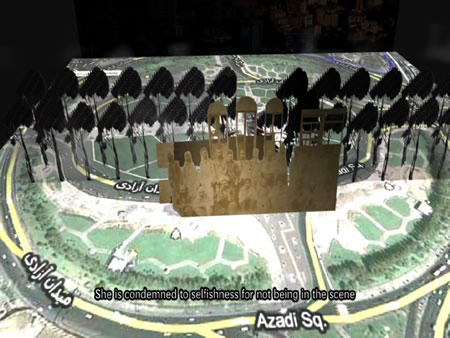 Morehshin Allahyari is an interdisciplinary artist and an art activist. She was born and raised in Iran and moved to the United States in 2007. One important aspect of her work is related to the social, political and cultural issues of Iran specifically women, self-censorship, censorship, and in general the daily life of the today Iran. Since she has moved to the U.S, she has also been working on intercultural projects, addressing her daily life as an Iranian in the United States of post 9/11. She has a MA in Digital Media Studies from the University of Denver and currently is a M.F.A candidate in New Media at the University of North Texas. She has served as the organizer and one of the co-founders and artists of "Dialogue": presented by IRUS art (an intercultural collaborative art show between artists in Iran and the United States). Morehshin is currently co-curating another collaborative project between the American and Iranian artists called "Your Night/My day". |
Morehshin Allahyari (Iran/USA) Over There Is Over Here explores the dialectics of time, space, real and unreal to define and critique the position of those who have left Iran in the last 4-5 years in relation to current political prisoners in Iran. The project uses 3D animation as a way to illustrate presence-less presence and to show the passage and collapse of the timeless time. Timeless Time: In my recent trip to Iran, I found a picture of political prisoners in my grandmother’s album, which is at least 100 years old. Looking at the prisoners chained to each other, I saw a tragic relationship between the past and the present of Iran, then and now, there and here; a shared pain from the same soul, generation after generation. In my animation, the concept of time is used not only to explore a relationship between past and present, but as a non-linear and collapsed concept in which the past and present have come together in order to create an “un-real” reality. Presence-less Presence: Through a self-reflexive narrator, Over There Is Over Here alternates between the literary definition of a third person narrator to my actual, physical “third person” role outside Iran as narrator of the story. The narrator explores my relationship with imprisoned friends and classmates. In this relationship, I am the outsider who will always fail to understand the reality of a prisoner’s life. The more I live outside Iran, the more I will forget details of the “reality” of life inside Iran. For these reasons, the animation is a deliberate mix of real and un-real, fake and genuine. |
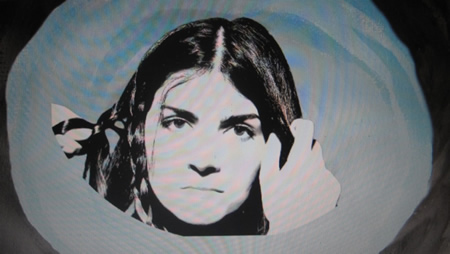 Maneli Aygani, painter- video artist. Born in TEHRAN, IRAN, 1981. BA in Graphic Design, Soureh University, Tehran, 2007. M.F.A candidate, University of Minnesota, USA, 2012. Exhibitions: Inside/outside exhibition, Arctic fury festival, Rovaniemi, Finland, 2010. Sanctioned array video screening, New York City, USA, 2010. Silkscreen piece, Personal Geographies/Bohemian Histories, Group show, 1419, Minneapolis, Minnesota, USA, 2010. Group Exhibition, Warren Robins Gallery, University of Michigan, school of art and design, Michigan, USA. 2010. Video installation, Azad Art Gallery, Tehran, Iran, 2010. Micro stop-motion installation, Collaboration in FantaShanty Project, Medicine Lake of Plymouth, Minnesota, USA, 2009. Group Exhibition, Seyhoun Gallery, California 2009, USA. Two-person Exhibition, Aaran Gallery, Tehran, Iran, 2008. Group Drawing show, Laleh Gallery, Tehran, Iran, 2004. Group Drawing show, Azad Art Gallery, Tehran, Iran, 2003. Solo Illustration Exhibition, Aks Café, Tehran, Iran, 2003. |
Maneli Aygani (Iran/USA) Where and how did we grow up? How have we learned to be afraid of each other? How have we enjoyed the approval of others for what we really aren't? How long those "others" and this "enjoyment" last? Censorship is internalized. We become experts at it, as if it were an inseparable part of our lives. It is precisely then that we loose the ability to distinguish what the I really wants. All the rigid concepts like Good and Evil form dissonances between our mental universe and the world around us; finally, while we understand that which we desire, we ruthlessly start a process of self-flagellation, because if our desire refuses to abide by our stock of knowledge, it will appear impudent and unusual. Thus, what is ravaged is the I, and at times, when we overcome this false I through continuous inner struggle, and stand our ground for that which we desire, the main tragedy then takes place. The I that harms the world is often more unpleasant than the I that harms itself. Then, this evil I will remain and a feeling of guilt. To what extent does this feeling of guilt, rather than our acumen, determines our actions? In this vicious circle cruelty comes to us from others, from us to the self, and from us to others. We are all engaged in hurting ourselves and hurting others. And, the moment that this cruelty becomes commonplace, a falsehood replaces truth, and the I gets lost in the middle of truth and falsehood and cannot distinguish between the two. This is a what-do-I-want that is lost. And the I gives up. |
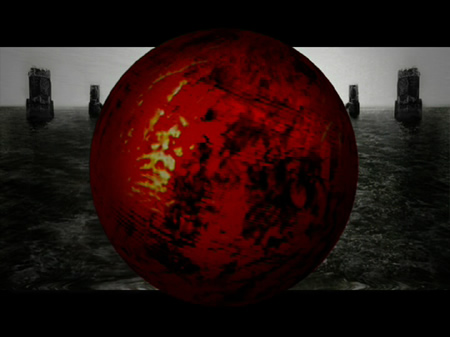 It is part of a video installation and is devoted to the Mothers and women who lost their loved ones in War. Have you ever missed your husband, your parents, your children, all the things spiritual and material that mattered in your life? The sky border is my homeland To me war has no place in the world. Its only purpose then, is too bring pain and suffering. To divide nations, peoples and culture. I participated in the Athena Video Art festival in 2008 with two other Iranian video Artists from Iran. Farideh Shahsavarani and Mohamad Reza Razdasht who recently passed away and was the victim of the senseless war between Iran and Iraq. They are called "Martyrs", but in reality they are people, like ourselves. It is our duty to speak loudly in the world, "NO TO WAR." If our message reaches and influences even 1 person, we reach our Goal, because 1 person does make a difference, and multiplied by many can change the World. (Neda Darzi) |
Neda Darzi (Iran) Born in 1971 obtained her diploma from Tehran girls school of art in 1992. Pursuing higher education, got B.A from Tehran open University and M.A in painting from art university in Tehran 1999. Has held 8 solo exhibitions and taken part in more than 47 group shows in Iran, France, Italy, Spain, Turkey, Greece. By using some of her original Tapestry, ceramic, and photographs, she has also been involved with making conceptual video installations, which reflect Iranian culture as well as her own identity. "My interest in video installation is the creation of a simulated experience. The archiving of information and imagery is much like memories I have collected from my past and childhood memories. Despite the tactility of my tapestry sculptures, the projected moving image requires only act of watching by the viewer. Unlike the sculptures that are within the space of the body and have direct interaction with the viewer, the video installations are imitations of the reality. I am interested in combining these two media to engage the viewer both physically and virtually." Different Videos such as: |
|
Samira Eskandarfar (Iran) Samira Eskandarfar was born in Tehran in 1980 and continues to work in Iran. Between 1997 and 2001 she studied Ceramic Engineering before going on to study filmmaking and finally take a Master of Arts in Animation. Since 2001, she has held over ten solo exhibitons and has participated in over forty group exhibitions and screenings internationally including the United States, United Kingdom, France, Switzerland, Netherlands, Serbia and Turkey. Eskandarfar has done workshops with the legendary Iranian filmmaker Abbas Kiarostami, and has shown extensively both in Tehran and outside Iran at various film festivals. Since 2003, she has made over ten videos from which two of her works were purchased by major collectors including the Tate Modern in London and Neuer Berliner Kunstverein (NBK) in Berlin. |
 Gelare Khoshgozaran is a photo and video artist, born 1986 in Tehran, Iran. She finished her undergraduate studies in Photography at the University of Arts in Tehran. In 2009 she joined the MFA program at the University of Southern California where she is currently a second-year MFA candidate. |
Gelare Khoshgozaran (Iran/USA) "This video comprises thirty five stills—screen shots—from a home video of my family, back in 1989. It was shot a couple of months after the war was over. We had returned to Tehran from our temporary refuge in a village near the city. We had gotten together at my uncle’s house to celebrate the occasion of my aunt’s birthday; while the whole event was an excuse for us to get together and make a documentation of our reunion and sending it to their son who was a refugee in Norway at the time... In the last four minutes of that video when everyone was dancing, I was lying in my father’s arms, the war was over and we were a family documenting our reunion and sending it to one that was “not there”. |
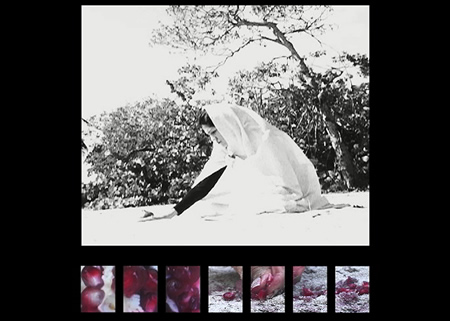 Though grounded in the aesthetics and culture of ancient Persia, this video is best understood as an abstract meditation on the concepts of loss and longing. Centered on the repetitive, even compulsive behavior of a single, unidentified figure as she continuously rakes the sand with her fingers, Raheleh suggests the need of this kind of memorializing ritual, while at the same time pointing toward the inadequacy of any such gesture. |
Laleh Mehran (Iran/USA) |
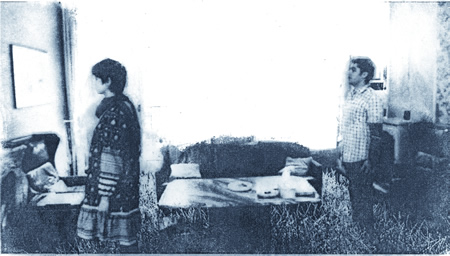 Poeticide (Shaer Koshi) in a rather lethargic mood, a girl is disillusioned by the harshness of events that affect her life. She sees herself trapped in a constant nightmare, from which she finds no exit. The whole story revolves around dreams and memories. There are some shots which the audience might experience that some parts are missing like a piece of dream or memories which they could recall in duration of the movie. |
Payam Mofidi (Iran/France) "Poéticide (shaér koshi)" 2009-2010, 11:25 Payam Mofidi is an Iranian contemporary artist who was born in May, 1980 in Tehran. He has studied graphic design in Azad university (Art and Architecture) in Tehran and then he continued his education in animation in school of arts (l’Ecole Nationale Supérieure des Arts Décoratifs) in Paris. He has started his professional career after he finished his studies and currently he is busy with making short film animations and experiencing new methods in the creation of them. There was a presentation of his recent animation, poeticide (Shaer Koshi) in many different festivals world-wide such as Festival « Temps d’images » in France. French animation festival in the Franco-Japanese Institute/Yokohama. Projection in the Short Films Evening, Prague. Projection in the short film evening "Iran Vs ..." Istanbul. |
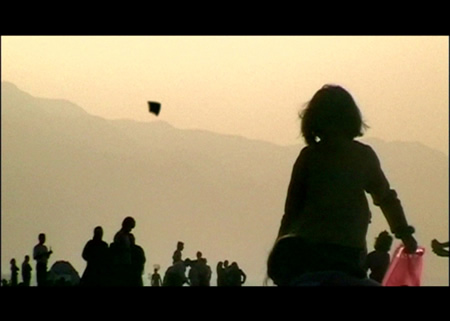 "One of the most common places for vacations that Iranian mostly from Tehran go there is Caspian shore in north of Iran. At the same time you can see many different types of people who enjoy their time. This video belongs to this happening." (Hamed Shahihi) |
Hamed Shahihi (Iran) "Sundown" 2009, 3:30 Born in 1980 in Tehran, Hamed Sahihi is one Iran's most intriguing painters. Trained in Tehran and graduating with a Master of Arts in Painting in 2003, he has since gone on to enjoy considerable success in Iran, with several solo shows in Tehran and participation in over twenty group exhibitions. His style is easily recognizable. From early on his figures have tended to float in space, giving a dreamlike feel to his works. In fact one haunting series produced in 2004 was called simply 'Dreams'. Since then he has painted series of people reading books, of distorted close-up portraits, of aerial views of cities that make them look like toys, and most recently of clowns. Sahihi has also enjoyed some success as a filmmaker, having made several short films and video animations over the past five years, and having attended workshops with the legendary Iranian filmmaker Abbas Kiarostami. |
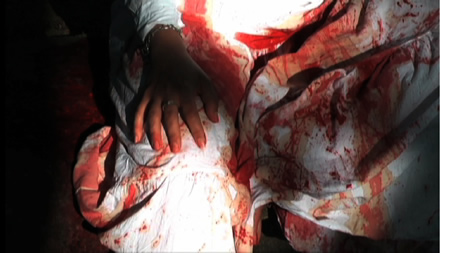 "The focus in my latest video is showing the psychological state of a woman through her face who is flirtatiously smiling. A woman who is happy and laughing. The audience immediately believes that it's a happy calm moment, yet half way through everything changes and with an audio-visual shock they understand that the woman not only is not happy but is actually dying. The smile turns cold and the woman is shown sitting in her blood. My goal in this video was to show how humans are such complex beings that it's very difficult to understand one's inner feelings from just the gestures on the face. This is a universal fact, someone laughs but inside bares thousands of worries and sadness or on the contrary, one might seem sad and oppressed while from within she is mocking the situation. In the other side I played with the situation of women of my country, Iran, that thay have a lot of problems, various problems in family, in society, with force of government who ignores them. Yet they're alive, active, they have pain but they go out, they laugh and continue bravely. Studying the face and expressions of humans, a being which is not even known to itself. What is the truth? There is no truth. I can't see an absolute in the universe, but to relieve myself from these mysteries I will continue with my work." (Parya Vatankhah) |
Parya Vatankhah (Iran/France) "Inevitable" 2010, 3:40 "My favorite subject has always been love and the feelings of women. The unrest in the society, the troubles I witnessed, the loneliness and solitude of women when they can't be independent. And my favorite shape, a woman's body... How time flies when you do what you love with all your heart... Even if their motives are your anguish, grief and pain, and other's... Even when your thoughts are dark. With a smiling and calm face, I am turbulent inside, filled with pain and longing... Longing for good days in Iran and pain, pains of me and of us... And art is sometimes my way of freeing from these thoughts." Parya Vatahkhah was born in Tehran, in 1976. Her love of the arts began in her childhood. She studied painting in Tehran university. She exhibited her works in important galleris in Tehran. From 2000 to 2009 she was in more than 20 individual and group exhibitions, including an exhibition in Paris, in 2006. Her most recent exhibition was in Toronto, Canada, where she showed her first video art, "Metamorphose". After 5 years of teaching in universities of Tehran and having exhibitions, she decided to leave Iran for a change of experience, for fresh air, for feeling freedom. And she chose France which was the place of her dreams for a long time. Parya continues her studies in France, for her second Masters in Plastic Arts. Parya states: "here I am sad, far from Iran and my family, but I feel I can do what I want and what I could not do in Iran." |
